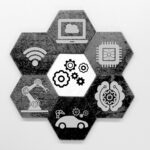In the digital age, the term AI is crucial for understanding in the 21st century. It’s changing how things work in healthcare, finance, education, and manufacturing, making processes more efficient and bringing about groundbreaking solutions. Even though we might not notice, it’s now a big part of our everyday lives, driving innovation in different industries. As AI becomes more independent, it raises questions about ethics and responsible use. Being informed helps us join conversations about AI ethics and ensures that these powerful tools are used for the greater good. But how does AI learn and change based on new information? This blog looks at how AI bridges the gap between machines and human-like intelligence.
What is AI?
In today’s fast-paced world, if you want to get things done quickly – learning, solving problems, understanding languages, and even being creative – you can turn to artificial intelligence (AI). AI is like a smart computer system that learns and improves tasks over time without someone telling it exactly what to do. It’s not just a tech thing; AI is everywhere, from healthcare and finance to education and manufacturing. There are two main types of AI: one that’s good at specific jobs like recognizing images or understanding speech (we call it narrow AI), and another that’s super smart and can handle any task a human can (that’s general AI). So, next time you see something working super efficiently or solving problems on its own, there’s a good chance AI is behind it!
Importance of AI
Artificial Intelligence is crucial for our future. It’s not just a tool; it’s transforming our world. It’s used in various areas like manufacturing, customer service, and data analysis, handling tasks faster and on a larger scale than we can. AI sparks innovation and pushes limits. It’s excellent at processing big data, aiding in informed decision-making for businesses and governments. AI is also tackling significant challenges like climate change and healthcare disparities, bringing new solutions and speeding up progress. In simple terms, AI is changing how we live and work for the better. Here we’ll explore the profound importance of AI and how it is transforming the world as we know it.
- AI in healthcare is changing how you experience medical care. It speeds up diagnoses and enhances accuracy by analyzing your genetic info and lifestyle. Virtual assistants and chatbots improve how you interact with healthcare. AI reduces time and costs in admin tasks, giving more time to healthcare professionals for personalized patient care, promising a more efficient and accessible future.
- By embracing AI in education, you benefit from a learning environment that adapts to your pace, tailoring content based on your performance. Automated grading not only saves your educators time but ensures you receive timely feedback, deepening your understanding. Beyond the classroom, online education platforms powered by AI open global access, promising to empower teachers and enhance your learning experience for a more connected and informed future.
- AI automates repetitive tasks like data entry, sorting, and basic decisions, freeing up human workers. This allows you to focus on creative and strategic work. In fields like finance and marketing, AI helps optimize processes and adapt to market changes quickly. AI-powered tools, such as chatbots and virtual assistants, improve customer service efficiency by handling tasks like scheduling meetings and organizing emails, ensuring faster responses and constant availability.
- In the age of rapid city growth, you can witness the rise of safer, smarter cities with AI. AI isn’t just about futuristic ideas; it’s a smart solution to urban challenges. From handling disasters to health crises, AI models help cities respond swiftly and allocate resources effectively. By using AI this way, cities improve safety, efficiency, and overall resident well-being. Balancing innovation with ethics ensures these advances benefit everyone, promising a better urban future.
- With AI, you’re entering a new era in scientific research. In various fields, AI accelerates research, deciphering intricate data and uncovering patterns beyond traditional methods. In pharmaceuticals, it’s transforming drug discovery by analyzing molecular structures and simulating interactions. AI doesn’t just speed up breakthroughs; it expands exploration, reshaping how we understand and discover. As technology progresses, the collaboration between AI and science holds the promise of a revolutionary future.
Understanding Human Cognition
Human cognition involves the mental processes used to gain knowledge and understanding. This includes thinking, learning from experiences, and using our senses. Key functions of cognition are perception (how we see and understand the world), memory (how we store and recall information), attention (what we focus on), language (how we use words), problem-solving, decision-making, and reasoning (how we make sense of things). Understanding these processes helps us see how complex human thought is and highlights the challenges of creating artificial intelligence that can mimic these human abilities.
Perception: Perception is how we interpret and organize information from our senses—sight, sound, touch, taste, and smell. It helps us understand our environment by recognizing and making sense of what we see, hear, feel, taste, and smell. Through perception, we can understand complex visual scenes, recognize faces, hear and interpret sounds, and move around safely.
Memory: Sensory memory, short-term memory, and long-term memory help store, retain, and recall information. Declarative memory includes episodic memory (personal experiences) and semantic memory (facts and knowledge). Non-declarative memory involves skills and habits, like riding a bike or typing on a keyboard.
Attention: Attention is focusing on specific information while ignoring other things. There are different types: Sustained Attention (staying focused over time), Selective Attention (focusing on one thing and ignoring others), Divided Attention (handling multiple tasks at once), and Executive Attention (managing complex or new situations).
Language: Language is a complex skill that involves understanding, producing, and communicating with words. It is essential for thinking, allowing us to express ideas, share information, and interact socially. Through spoken, written, or signed words, language helps us connect with others and navigate the world around us.
Problem-Solving: Problem-solving means identifying a problem, understanding its details, brainstorming possible solutions, evaluating each solution’s feasibility and effectiveness, choosing and applying the best solution, and monitoring its success. This process uses analytical thinking, creativity, and the decision-making skills of humans.
Decision-Making: Decision-making involves choosing the best option by evaluating different choices, considering potential outcomes, acting on the selected option, and reviewing the results. This process can be influenced by emotions, biases, and past experiences, affecting how decisions are made and their overall effectiveness.
Reasoning: Reasoning involves logical thinking to understand complex information. Deductive reasoning uses true premises to reach true conclusions whereas Inductive reasoning finds patterns to make generalizations, but these conclusions aren’t always certain.
Machine Learning: The Heart of AI
Machine learning (ML) is a key part of artificial intelligence (AI) that focuses on creating algorithms that let computers learn from data and make predictions or decisions. Unlike traditional programming, which uses specific rules and instructions, machine learning uses data to find patterns, relationships, and insights. This allows computers to get better at tasks over time without needing explicit programming for each situation. You can rely on ML to help improve performance and efficiency in various applications.
The Basics of Machine Learning
- Supervised Learning: Supervised learning involves training a model on a labeled dataset. Through this learning model, you learn to make predictions by comparing your output with the actual labels and adjusting your parameters to minimize errors. Common uses include classifying images, detecting spam, and making predictions. By doing this, you can teach your model to recognize patterns and make accurate predictions based on new data.
Example: Image Recognition
In image recognition, there’s a type of AI called a supervised learning algorithm. Think of it like teaching a child to recognize cats. You show the AI thousands of pictures, some with cats and some without, and you tell it which ones have cats and which ones don’t. Over time, the AI starts to learn what features make a cat a cat, like its shape, fur patterns, and face. So, after seeing enough examples, the AI can look at a new picture and say whether it has a cat or not.
- Unsupervised Learning: Unsupervised learning involves training a model on data without labeled responses. This way, you can easily find patterns, clusters, or associations in the data. You use techniques like clustering (e.g., k-means) and association (e.g., market basket analysis), which are useful for exploratory data analysis, customer segmentation, and anomaly detection. By using this learning model, you can discover hidden structures in your data without needing specific labels.
Example: Customer Segmentation
Imagine you have a bunch of customer shopping data, but no labels or categories. Unsupervised learning is like letting the AI figure out the patterns on its own. The AI looks at all the data and notices groups of customers who buy similar things. It sorts these customers into different groups based on their buying habits. This way, businesses can target each group with specific marketing strategies that fit their interests.
- Reinforcement Learning: In reinforcement learning, one learns by interacting with the environment and receiving feedback in the form of rewards or penalties. The goal is to maximize the cumulative reward by making a series of decisions. This learning paradigm can be likened to training a pet: you reward good behavior and discourage bad behavior. Similarly, in reinforcement learning, you receive a reward for positive actions and a penalty for negative ones. This approach finds applications in various fields, such as training robots for tasks, enhancing the strategies of video game characters, and improving the safety of self-driving cars.
Example: Game Playing
AI is like teaching a computer to learn from data. By showing it many examples, like pictures of cats, the AI learns to recognize new pictures of cats on its own, just like a child learns by seeing many examples.








